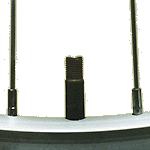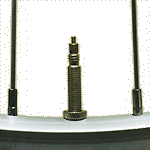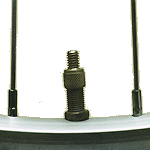Clincher Tyres
Conventional tyres used on 99% of all bicycles are "clincher" type, also known as "wire-on." They consist of an outer tyre (the "casing") with a U-shaped cross section, and a separate inner tube. The edges of the tyre hook over the edges of the rim, and air pressure holds everything in place.
Many people suppose that tyres are made out of rubber, because that's what is visible. This is a major oversimplification--rubber is the least important of the three components that make up a tyre:
-
Bead
The "bead" is the edge of the tyre. On most tyres, the beads consist of hoops of strong steel wire. The beads hold the tyre onto the rim, and are, in a sense, the "backbones" of a tyre. While most beads are steel, some tyres use Kevlar ® cord instead.
-
Fabric
Cloth fabric is woven between the two beads to form the body or "carcass" of the tyre. This is the heart of the tyre, the part that determines its shape. The vast majority of tyres use nylon cord, though some use other polyamides. Up until the 1960s, cotton/canvas was commonly used. It was not as strong, and was prone to rot. Cotton and silk are still used for some tubulars.
The fabric threads don't interweave with crossing threads as with normal cloth, but are arranged in layers or "plies" of parallel threads. Each layer runs perpendicular to the next layer(s).
Some tyres use thick thread, some use thin thread for the fabric. With thin thread, there are more threads per inch ("TPI") and this number is often considered an important indication of tyre performance.
The higher the TPI number, the thinner and more flexible the tyre fabric is. Thin-wall (high TPI) tyres tend to be lighter and have lower rolling resistance, but they're more easily damaged by road hazards.
Bicycle tyres have the threads of the fabric running diagonally, ("bias") from bead to bead. Modern car tyres have the main threads running straight over from one bead to the other, known as "radial" construction. Radial tyres will also have a "belt" of plies running all the way around the circumference of the tyre, crossing the radial plies.
Radial tyres have been tried for bicycles, but they tend to be too floppy from side to side. This floppiness feels quite unpleasant in actual riding --much like the feel of a grossly under-inflated tyre.
Some bicycle tyres also have a Kevlar ® belt running under the tread area, in addition to the normal bias plies. This is intended as a puncture preventive.
-
Rubber
Once the fabric has been woven between the beads, and the tyre has its basic shape, it is coated with rubber. The rubber is mainly there to protect the fabric from damage, and has no structural importance.
The rubber that comes into contact with the ground is called the "tread." This area usually has thicker rubber than the "sidewalls" of the tyre, mainly for wear resistance. Most tyres have some sort of 3-dimensional pattern moulded into the tread, which may or may not enhance traction.
Manufacturers mix different additives with the rubber to achieve desired traction/wear characteristics. Generally, a softer formulation will give better traction, but at the expense of more rapid wear. Rubber is normally a sort of tan colour, but most tyres are black. This is the result of adding carbon black to the mix. Carbon black considerably improves the durability and traction of the rubber in the tread area.
Some manufacturers substitute a silicon compound for the carbon black. These tyres usually have a grey tread. Whether silicon or carbon black provides better traction is subject to dispute. Grey-tread tyres are preferred for indoor use (for example, on wheelchairs), because they do not leave black marks on floors.
"Dual compound" tyres feature a centre strip of fairly hard rubber for improved wear, with a softer, grippier formulation toward the sides of the tread. The intent is to provide better cornering traction without compromising the life span of the tread.
Many bicycle tyres are "gumwalls" or "skinwalls." Gumwall tyres have tan sidewalls, with no carbon black. This may make the sidewalls slightly more flexible, reducing rolling resistance. It is not clear to what extent this makes a difference.
Skinwalls have either no rubber on the sidewalls, or a very thin layer. This, too is an attempt to make the sidewall more flexible and reduce rolling resistance.
-
Tubular Tyres
Tubular tyres, also known as "sew-ups" or "sprints" differ from clinchers in that they don't have beads. Instead, the two edges of the tyre are sewn together around the inner tube. Tubulars are used on special rims, and are held on to the rims by glue. Tubulars used to be fairly common on high-performance bicycles, but these days they are an endangered species.
| Tubular Pros: | Tubular Cons: |
- Tubulars are a bit lighter than comparable clinchers, due to the absence of the beads. The development of Kevlar® beads has considerably reduced this advantage.
- Tubular rims are lighter than clincher rims, since they don't need the flanges that hold the beads of a tyre in place.
- Tubulars are less prone to pinch flats than clinchers, since the rims don't present the sharp edges of the clincher flanges.
- Many riders believe that tubulars provide a more comfortable ride and better traction than clinchers.
- If you get a flat on a tubular, you can install a spare tubular faster than you can change an inner tube in a clincher.
| - Tubulars are considerably more expensive than clinchers of comparable performance.
- Tubulars are very much harder to repair once punctured. Most people just throw them away.
- You need to carry a complete spare tubular in case you get a flat. This negates the weight advantage over clinchers, unless you have a team car following you with spare wheels.
- Improperly glued tubulars can roll off the rim. This almost always causes a serious crash.If you replace a tubular on the road, you cannot corner safely at high speeds until you go home and re-glue the tyre. For safe high-speed cornering, the glue needs to dry for at least several hours.
- Tubulars have higher rolling resistance than the best clinchers.
- Tubulars are rarely as true and round as clinchers.
|
-
Inner Tubes
An inner tube is basically a doughnut-shaped balloon, with a valve for inflation. The only requirement for an inner tube is that it not leak. Being of rubber, it has no rigid structure. If an inner tube is inflated outside of a tyre, it will expand to 2 or 3 times its nominal size, if it doesn't explode first. Without being surrounded by a tyre, an inner tube can't withstand any significant air pressure
| Valve Types: |
 |  |  |
| Schrader valve | Presta valve | Woods/Dunlop valve |
Butyl vs Latex
Before World War II, tyres and tubes were made from natural latex rubber, harvested from tropical trees. When the supply of natural latex was insecure during the war, a substitute, "butyl" was invented. Butyl turned out to be a very successful substitute, better, in fact, than latex for this application. All modern tyres and most inner tubes use butyl rubber.
Some riders prefer latex inner tubes, because they can be a bit lighter than butyl ones. Some riders believe that latex tubes have less rolling resistance than butyl.
Latex tubes are commonly a bit more porous than butyl ones, and need to have their pressure topped off more often.

How a Tyre Supports its Load
It is commonly thought that the air pressure in a tyre supports the rim. If you think about it, this can not be true because the air pressure against the rim is equal, top and bottom. How, then, does a tyre support its load?
First of all, the role of air pressure in the tyre is to hold the fabric under tension -- in all abut one place, the contact patch with the road surface.
At the contact patch, the tread of the tyre is flattened against the road. Air pressure can only push directly outward, and so here, it pushes directly downward. The downward force of the air must equal the weight load, and so the area of the contact patch equals the weight load, divided by the air pressure. For example, if the air pressure is 50 PSI, the contact patch will be two square inches.
The threads of the tyre fabric can only transmit loads lengthwise and in tension. They bulge out to the sides. How then, is the load transfered from the contact patch to the rim?
The load is first transferred from the contact patch to the tyre sidewalls by the shallower angle and lower tension of the threads either side of the contact patch -- they are pulling downward less and outward more. The load is similarly transferred from the sidewalls to the rim by the shallower angle and lower tension of the threads of the fabric where they meet the rim. As the threads pull downward less, they also pull outward more, but the outward forces at the two sides are equal and opposite, and cancel out.
These effects together produce the bulge seen at the bottom of a tyre under load. Because the contact patch is flat aganst the road, the curvature of the sidewalls is increased -- the tyre becomes effectively thinner, not counting the inactive width of the contact patch.
Wth a bias-ply tyre, the load is carried lengthwise in both directions along the tyre by the diagonal threads, so the bulge is longer and less deep than on a radial-ply tyre. In the early days of radial-ply car tyres, people often thought they were underinflated, because the bulge at the bottom was more pronounced.
A tyre, then, supports its load by reduction of downward pull, very much the same way that spoking of the wheel supports its load. The tension-spoked wheel and the pneumatic tyre are two examples of what are called preoaded tensile structures, brilliant, counterintuitive designs working together remarkably to support as much as 100 times their own weight.
Bias plies also help to transmit lateral and torque loads, by triangulating the connection between the contact patch and the rim -- much like the way the spokes of a semi-tangent spoked wheel transmit lateral and torque loads. With tubulars, the diagonal plies also work like a Chinese finger puzzle: the air pressure makes the tyre fatter, and so makes it shorter and helps hold it to the rim.
If you would like to get into mathematical details, there is an excellent technical description in an old Britannica encyclopedia article online.




No comments:
Post a Comment